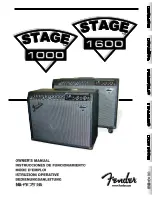
168
WhitakerAudio
•
Adjust the generator to produce 7.2 V rms output at the speaker terminals with an
appropriate load..
•
Observe the trace displayed on the oscilloscope. Adjust the Bass and Treble controls for
the best response. The Bass control will impact the flatness of the waveform and the
Treble control will impact the response of the leading edge of the waveform.
•
The positions of the Bass and Treble control, following this procedure, should closely
match the “flat” response positions.
With the tone controls adjusted, the square wave observations can now be made.
•
Adjust the generator to produce 7.2 V rms output at the speaker terminals with an
appropriate load for the 10 W tests. Adjust the audio generator to produce 100 Hz, 1 kHz,
and 10 kHz. Observe the results and compare with Figure 7.2
•
Adjust the generator to produce 2.3 V rms output at the speaker terminals with an
appropriate load for the 1 W tests. Adjust the audio generator to produce 100 Hz, 1 kHz,
and 10 kHz. Observe the results and compare with Figure 7.2.
The following observations can be made regarding typical square wave performance at
various power levels and frequencies:
•
At 1 W power output –
a
) A fair amount of low frequency tilt is observed at low
frequencies (100 Hz and below).
b
) The response at 1 kHz looks quite good.
c
) The
response at 10 kHz is respectable, with no signs of instability.
•
At 10 W power output
–
d
) Considerable low frequency tilt is observed at low
frequencies (100 Hz and below).
e
) The trace at 1 kHz looks good, with slight ringing on
the leading edge.
f
) At 10 kHz the trace shows significant ripple, which is not entirely
unexpected at the operating limit.
Restating the obvious, operation of this amplifier (or any other amplifier) at its maximum
operating point has performance penalties. However, for listening at modest levels, the amplifier
performs quite well.
7.2.6
Bias Adjustment
The bias setting for the amplifier is critical to proper operation and long-term reliability. The
recommended bias setting of –30 V has been found to be a good operating point for this amplifier
and to provide for long tube life. If desired, however, the bias may be tweaked as follows:
Summary of Contents for JC Whitaker 20 W Stereo Integrated Audio Amplifier
Page 1: ...20 W Stereo Integrated Amplifier WhitakerAudio 20 W Stereo Integrated Audio Amplifier ...
Page 11: ...11 20 W Stereo Integrated Audio Amplifier Figure 1 1 b ...
Page 16: ...16 WhitakerAudio Figure 1 2 b ...
Page 20: ...20 WhitakerAudio Figure 1 3 Power management circuit for the 20 W integrated stereo amplifier ...
Page 38: ...38 WhitakerAudio Figure 3 1 Component layout for the Amplifier PWB 1 right board ...
Page 40: ...40 WhitakerAudio Figure 3 2 Rectifier PWB component layout ...
Page 45: ...45 20 W Stereo Integrated Audio Amplifier Figure 3 4 Layout of the speaker terminal PWB ...
Page 84: ...84 WhitakerAudio Figure 5 6 Power management PWB a component side b foil side a b ...
Page 188: ...20 W Stereo Integrated Amplifier WhitakerAudio 20 W Stereo Integrated Audio Amplifier ...
Page 196: ...196 WhitakerAudio ...















































